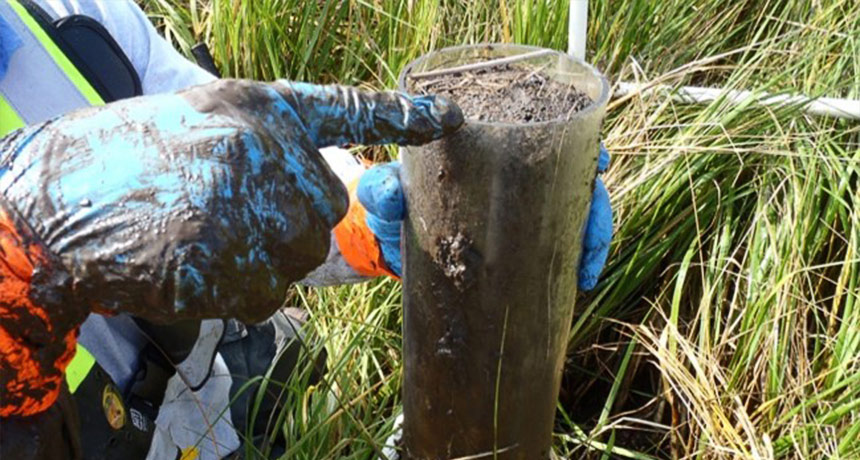Oil-munching microbes cleaning up Gulf marshes faster than expected
Five years after Deepwater Horizon spill, BP-funded study points to ecological recovery along the coast

OIL SPOILS In cores of sediment like this one pulled from a Louisiana marsh, researchers found busy microbes gobbling up oil from the 2010 Deepwater Horizon oil spill.
Courtesy Battelle
The 2010 Deepwater Horizon oil spill left the Gulf Coast’s vast and delicate marshlands in desperate need of cleaning. But soil microbes are on the job.
Since the spill, populations of oil-degrading microbes have boomed in some of Louisiana’s most heavily oiled marsh soils. These invisible-to-the-eye janitors are breaking down the goopy brown oil faster than expected, scientists report June 19 in Environmental Science & Technology. Although some researchers are skeptical of the data, the study hints at a relatively speedy ecological recovery.
“This has been an amazing microbial response,” says microbiologist Ronald Atlas of the University of Louisville in Kentucky, lead author of the study and a consultant for BP, the company that operated the Deepwater Horizon oil rig at the time of the spill. “Over 99 percent of the oil biodegraded in many of these marshes,” he says.
From 2011 to 2013, Atlas and colleagues collected a series of sediment samples from 20 marsh sites in Barataria Bay, just south of New Orleans, for the BP-funded study. Some of these sites sustained some of the heaviest oiling during the spill.
However, researchers collected only three complete years’ worth of samples from four of the sites. Some sites washed out to sea during the study. Heavy oiling is known to quicken erosion in marshes.
The researchers found many microbes capable of breaking down oil, particularly in the earliest samples. Those oil-munchers elbowed out other resident microbes. But, as oil levels decreased in subsequent years, the native microbial communities rebounded, the researchers found.
Using an oil sample known to be from the Macondo well, the source of the spill, the researchers could specifically identify oil from the spill and tell how much had degraded.
Weathering by such forces as heat and light had degraded more than 90 percent of some toxic Macondo oil components — polycyclic aromatic hydrocarbons —by the start of the study. The oil components most resistant to that weathering remained. By the end of the study, some sediments showed 98 to 99 percent depletion of PAHs, which the authors attributed to microbial breakdown.
This is surprising because most of these marsh sediments lack oxygen, a condition not known to spur quick microbial breakdown of oil, Atlas says.
Favorably warm temperatures and a history of spills and natural oil seeps in the Gulf may have primed microbes to gobble the muck, the researchers say.
The study is “showing Mother Nature doing her thing,” says environmental chemist Edward Overton of Louisiana State University in Baton Rouge, who was not involved in the study.
Others are skeptical of an ecological recovery. Wetlands ecologist Eugene Turner, also of Louisiana State, has collected hundreds of sediment samples, some from the same areas. He found that some of the oil components are not degrading at all.
And the levels of residual oil found in the new study are still about 20 times as high as the levels seen before the spill, adds Turner, who has pre-spill samples. As for the oily marshland washed out to sea, Turner says, there is no recovery.







